| |
To reduce
the seasickness and improve the comfort of passengers, some liners were
equipped with an anti-rolling system, just as some ships today.
In reality,
anti-rolling systems were invented for quite different reasons, they were
employed on military ships. In fact, reducing the rolling movements of the
ship, made it possible to aim the cannons and artillery more easily to the
enemy ship. Who aimed better, survived.
ANTI-ROLLING SYSTEMS:
Let's
examine the different systems, starting from the older.
|
|
| |
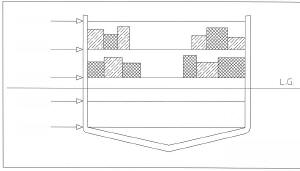 |
LOAD
REPARTITION:
Originating
in the Roman times, but on some occasions where it is needed, it is still
used nowadays.
It consists
of stowing the load, especially when it is about half or slightly less of
the full load, on the sides of the higher decks. In doing so, the weight of
the load applies strengths that work as a counterbalance, contrasting the
strengths that cause the rolling movements.
This
system also affects, though very little, the pitching motions. |
|
| |
|
|
|
| |
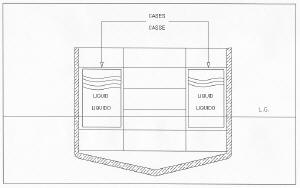 |
ANTI-ROLLING CASES:
Working
similar to the load repartition system, but in this case the weight is
obtained by tanks built inside of the hull and filled with water or mineral
oil. These tanks can extend long the entire length of the hull. The
disadvantage of this system is that wide liquid surfaces are free to
move,
consistently reducing the properties of stability of the ship. |
|
| |
|
|
|
| |
f_small.JPG) |
PASSIVE
WINGS:
They are slightly extended out profiles, running along the lower edges of
the hull, mostly in the central part of the hull. It is the more inexpensive
and system, used also on very small size boats. The efficacy increases with
the increasing both of the ships speed and the rolling motions speed. Anyway
it is not an efficient system. In the photo
is visible
the right
passive
wing of the liner "Cristoforo Colombo" the twin of the Andrea Doria. |
|
| |
|
|
|
| |
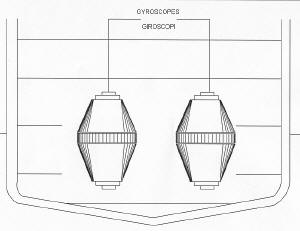

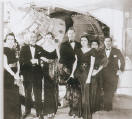
2 of the 3 spinning tops onboard the liner "Conte di Savoia"
under construction, and one group photo with some 1st class passengers
visiting them.
|
GYROSCOPIC SYSTEM:
It uses the
physic principles of the gyroscope, where one rotating mass produces a major
opposition against an external strength, working to alter its motion
direction.
It is
realized by 2 or 3 enormous spinning "tops", of which their rotation axles
move under the directions coming from a sensor that detects the lateral
inclination of the ship. The force of inertia of the spinning tops create an
opposition strength to the motion of the ship.
The first
passenger ship having this stabilizer system was the Italian liner "Conte
di Savoia", the brother of the famous "Rex", in 1932.
It was
composed of 3 spinning tops 100 tons each in weight, located toward the prow
section of the hull.
This system
had several limits. Firstly, the hulls of mercantile ships (different than
military ships) are not built to house so highly concentrated weights. These
abnormally heavy and concentrated loads cause enormous torsions strengths on
the hull, during the rolling and pitching movements, also altering the
stability of the ship. The hull of Conte di Savoia emitted frightful creaks
in the presence of bad seas.
Additionally, in rough and irregular sea, when quick and sudden movements of
the spinning rotation axles was required, the mechanism was not able to work
with sufficient speed. This brought the system into anti-phase, increasing
the rolling motion instead of working against it.
The low
efficacy, the high costs and the wide spaces required, soon brought to its
end. |
|
| |
|
|
|
| |
ACTIVE
STABILIZER WINGS:
It
is the more advanced and efficacious system, it
was installed on Michelangelo and Raffaello as well on several ships
nowadays.
It is based on the hydrodynamic thrust generated by one or more couple of
"wings" protruding from the hull under sea level. Their extension can be
from 1/2 to 1/4 of the hull width, and their width
vary
from 0,4 to 1,2 meters. The wings work similarly to the wings of an
airplane, but their inclination is commanded by a sensor that detects the
lateral bending of the ship.
Naturally,
the efficacy of the wings is proportional to their surface and to the speed
of the ship.
The weight
of the complex is about 1/4 of the gyroscopic system. As was on Michelangelo
and Raffaello, the wings could be retracted inside of the hull when not
necessary. This decreased the water resistance and the fuel consumption. |
|
| |
_small.jpg)
(JFA)_small.jpg)
One of the 4 stabilizer wings of the
Michelangelo |
|
| |
SCHEME OF ONE RETRACTABLE WING,
type "Denny-Brown", mounted on the liner Leonardo Da Vinci
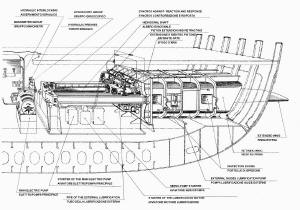 |
|
| |
|
|
|
r25.jpg)